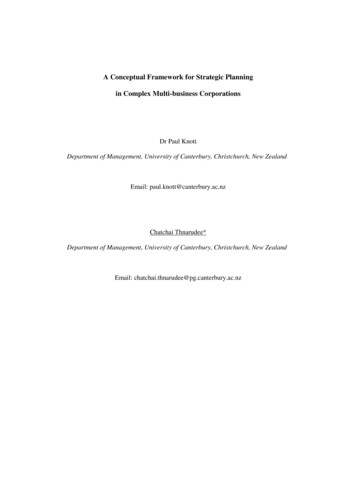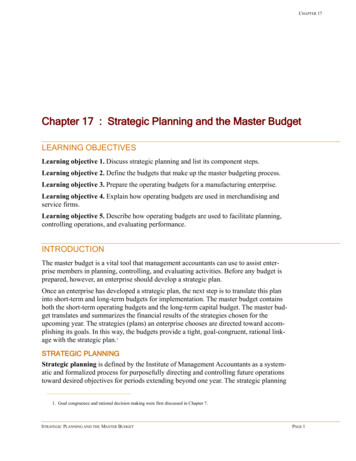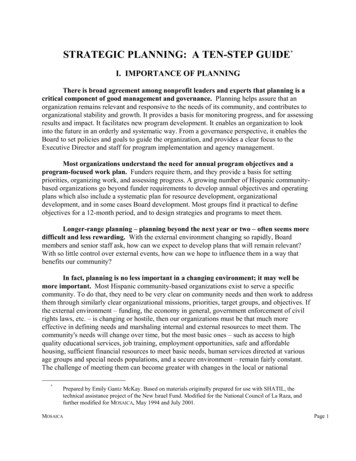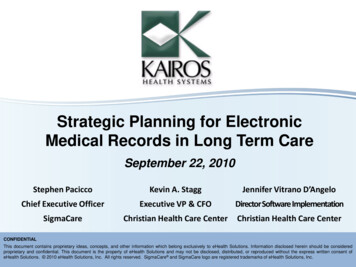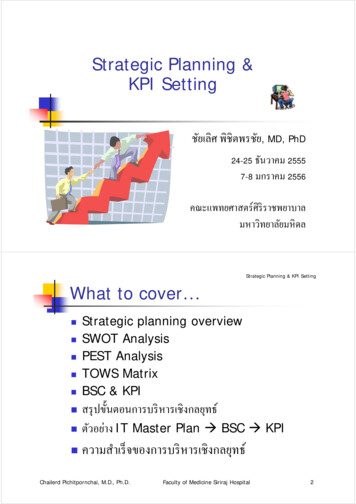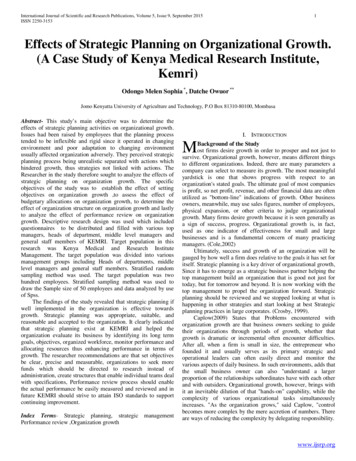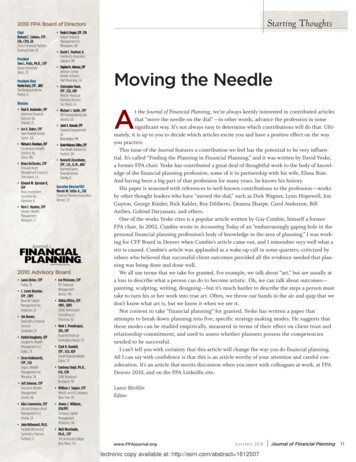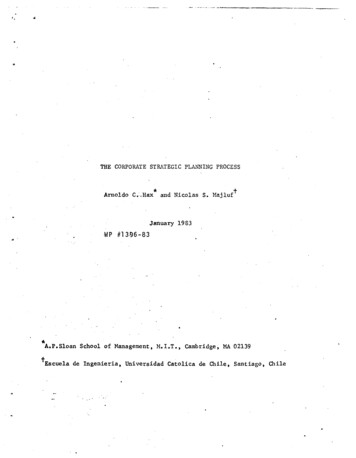
Transcription
THE CORPORATE STRATEGIC PLANNING PROCESSArnoldo C.:,Haxand Nicolas S. MajluftJanuary 1983WP #13 6-83A.P.Sloan School of Management, M.I.T., Cambridge, MA 02139tEscuela de Ingenieria, Universidad Catolica de Chile, Santiago, Chile
The Corporate Strategic Planning ProcessThe corporate strategic planning process is a disciplined and well-definedorganizational effort aimed at the complete specification of corporate strategy.In the words of Andrews (1980):Corporate strategy is the pattern of decisions in a company thatdetermines and reveals its objectives, purposes, or goals, producesthe principal policies and plans for achieving those goals, anddefines the range of business the company is to pursue, thekind of economic and human organization it is or intends to be,and the nature of the economic and noneconomic contribution itintends to make to its shareholders, employees, customers, andcommunitites. [It] defines the businesses in which a companywill compete, preferably in a way that focuses resources to conveydistinctive competences into competitive advantages.It is a complex matter to describe this process in general terms.We need toidentify not only the major tasks that have to be addressed in setting upcorporate strategy, and the sequence in which they must be completed, but alsothe assignment of responsibilities for the execution of those tasks.There are many hierarchical planning levels that depend very heavily uponthe diversity of businesses of the firm, its organizational structure, and theinterrelationship between strategy and structure.It becomes clear, then, thatthe precise specification of a corporate strategic planning process depends onthe particular characteristics of the situational setting confronted by thefirm.The planning process appropriate for a single business firm with a purelyfunctional organizational structure is quite different from the one suitablefor addressing the strategic tasks of a highly diversified multinational corporation.However, we believe that there are some common properties whose adequateuse can help in delineating the formal planning process for most business firms.At the risk of being overly simplisitic, we will go back to basics.InFigure 1 we have identified three conceptual hierarchical levels, which havealways been recognized as the essential layers of any corporate planning process:a corporate, a business, and a functional level.Regarding the nature of the planning tasks, we believe it is important to
-20,.4uuSU0T40Paa:jujo0IVIOCtx-sc0'-4P II0 V,E, 0o0·'oI4o-'t00pO0000k00 O,U-4P C0ci0PLto.Pto4-j0W)P4ma 040 l 44 ir-4r44 tz0SW(*q0U0 ci0O)4a*1CU 4-,)t.riJ 00--004- .4-iUWc44-4-U. EE0O4S J.J* *U)0 uC.CUa-00.4-*04-IIr, V 00 a04e04 U -ua)00Ociv-fo0CO;. 0 . C--t. 4 o, j0O0r-i0aU -O0CU0U-0c'0000k00 un4-)I.00'40,sW 00K zz . -r4J CO0U CU0.I-J00.oU00IrC0-H -H0Ca0,,0,CO,, 0 o,.,·u Oa00C)o0O(.,(Qrr-eele-!u.00U-oblU0-,q ).C-"4citocP 0I.C 0V.ciWcIo00-I·C0u00 WO m0 rD00.I.s- 0MJaU)00'4,.000*4 ahC0Wt.s,CQ)r: a -4-,H14P, I0C u )V0O-oIIICU0HL00O0 00C *0O-4-Ha-a4 0MiWJG-W C;-U,-4-U )UZCariDQW4-ciI- IIIUWC)0WO44:P.OCO40.0;* -1aCO b-H00Cc0U)ri06IP a--aC0i- 00 0 0a iciO O U)'ciCl0UWciIJ u00-C0U)4 0- c;:10cin-t*HtVa)a'C;WVmmU)4-oci-0Uir-4d04iW ,0.0U '-1 0 00ci- r4or-40u)E-VW -art 0Q0cc0a00Z0P4III to: enXJI0.,.: :oIC . -Mr4c0:iC
-3-distinguish, first, some activities which have a more permanent character.Although planning is a continuous process which is repeated year in and yearout in the life of an organization, there are certain basic conditions that seemto be more permanent and are not significantly altered in each planning cycle.We have referred to them as the structural conditioners of the business firmand thus are represented in Figure 1 by the vision of the firm, and the missionof the business.At the same time, there are three major tasks which need to be updated andrevised at every planning cycle: strategy formulation, strategic programming,and strategic and operational budgeting.The essence of the message portrayed in Figure 1 is that corporate planningis neither a top-down nor a bottom-up nrocess.It isa much more complex activitywhich requires a strong participation of the key managers of the firm, where objectives are being proposed from the top, and specific pragmatic alternatives arebeing suggested from business and functional levels.It is a process that,properly conducted, generates a wealth of individual commitments and personalparticipation from everybody who has a definitive say in sharpening up thedirection of the firm. It is a rich communication device,. where the key managershave an opportunity to voice their personal beliefs about the conduct of businesses of the firm, and offers a valuable joint experience as well as an educational opportunity to be shared by key participants.We provide now a brief description of the content of the corporate strategicplanning steps identified in Figure 1.Step 1: The Vision of the FirmThe vision of the firm is a rather permanent statement articulated primarilybyts Chief Executive Officer, addressing the- folowing-issues:1) Communicate the very nature of existence of the organization in terms ofcorporate purpose, business scope,-and competitive leadership;
III-42) .provide a framework that regulates the relationships between the firm andits primarystakeholders: employees, customers, shareholders, suppliers,and the communities in which the firm operates;3) state the broad objectives of the firm's performance in terms of growthand profitability.The mission of the firm has to be expressed so as to provide a unifying themeand a vital challenge to all organizational units, communicate a sense of achievable ideals, serve as a source of inspiration for confronting the daily activities,and become a contagious and motivating guiding force congruent with the corporateethic and values.The vision is a statement of basic principles that set apart those firmswhich have been able to articulate it in a positive manner from those which lagbehind in this respect.There are very few firms which can show well-definedstatements of mission.An individual working for a firm has to become an active collaborator inthe pursuit of the corporate purposes; he must share the vision of the firm andfeel comfortable with the way in which it is translated or expressed in traditions and values.The behavior of individuals is conditioned by this frameworkand they must intimately sense that, by following these guidelines, they arefulfilling their most personal needs for achievement.The vision of the firmis a personal drive for their own lives.Though the vision of the firm is a central thrust for a smooth developmentof corporate concerns, it is very hard to state it in unambiguous and pragmaticterms, and explain what it takes to develop and communicate the sense of vision.But the prop crealization of corporate strategic planning requires, as a firststep, that a statement of the vision of the firm be issued.We believe thatthree major components should be present in such a statement:1)an expression of the mission of the firm in terms of product, market, andgeographical scope; and a statement of the way to achieve competitive leader-
-5ship;2)the identification of the strategic business units(SBU's)of the firm andtheir interactions in terms of shared resources and shared concerns;3) an articulation of the corporate philosophy in terms of corporate policiesand cultural values.The Mission of the FirmA primary information that should be contained in a statement of missionis a clear definition of current and future expected business scope.This isexpressed as a broad description of the products, markets, and geographicalcoverage of the business today and within a reasonably short time frame, commonlythree to five years.The statement of business scope is informative not onlyfor what it includes; it is equally telling for what it leaves out.The specification of current and future product, market, and geographicbusiness scope communicates the degree of permanence that the business is expectedto have.In a widely popular article, Leavitt (1960) warns against excessivemarketing myopia.The essence of his message is to allow for a broad enoughdefinition of business scope in order to detect changes in the industry trends,the repositioning of competitors in terms of products, markets, and geographicalcoverage, and the availability of new substitutes.The contrast between currentand future scope is an effective diagnostic tool to warn against myopic positioning of the.business.An example of a mission statement which clearly communicates the threedimensions of the business scope is provided by the Automotive and.IndustrialElectronics Group of Motorola:-The mission of the Automotive and Industrial Electronics Group isthe development and production of electronic modules and power conversionequipment for sale to original equipment manufacturers (EMs) and theassociated replacement parts market.The product scope centers on volume production of electronic modules,in a variety of manufacturing technologies, for monitoring, control,information transmission, information display, and power conversion.
-6The market scope is the OEM and replacement market segment forinstrumentation, electronic power conversion systems, wire linecommunication equipment, vehicle power trains, appliances, OE passengercar entertainment, and systems refining visual display capabilities.The geographic scope is primarily North America and Europe, andsecondarily Japan, Latin America, and South Africa.The other important piece of information that should be contained in themission statement of a business is the selection of a way to pursue a positionof either leadership or sustainable competitive advantage.In this respect,we find Emhart's corporate mission statement to be unambiguously clear:The businesses within the Company are expected to achieve andmaintain a leadership position in attractive industries. A trueleadership position means having a significant and well-definedadvantage over all competitors. This can be achieved throughcontinuous, single-minded determination to achieve one or both ofthe following positions within an industry:1. Lowest Delivered Cost PositionA business with the lowest delivered cost has greater economiesof scale than other competitors. Economies of scale are available in the manufacturing, distribution and installation stepswhere large amounts of costs are incurred. Success at achievingthe position of lowest delivered cost is dependent upon identifying and concentrating upon that step where a concentration ofeffort will produce the most dramatic results.2. Differentiated ProductsDifferentiated products are those which offer the customer someimportant and unique benefit. Typically, patents, trademarks,brand names or specialized skills prevent competitors from copying such products. If a product is truly differentiated, thecustomer is selectively insensitive to price. Increasingcustomer price sensitivity is a sign that a product is losingits advantage of differentiation.Business SegmentationThe cornerstone of the strategic planning process is the segmentationof the firm's activities in terms of business units.One of the firstquestions to be addressed sounds deceptively simple, but in practice represents a most uhallenging and creative analysis:What businesses are we in?-A business can be defined as an operating unit or a planning focus thatsells a distinct set of products or services to an identifiable group ofcustomers in competition with a well defined set of competitors.The resultingentity is normally referred to as a strategic business unit, or SBU for short.
-7It constitutes the level of analysis where most of the strategic planning effortis centered.Rothschild (1980), a manager of Corporate Strategy Development and Integration at G.E., has listed the following criteria to be met before.; an organizationalcomponent is classified as an SBU:- First of all, an SBU must serve an external, rather than an internal,market; that is, it must have a set of external customers and notmerely serve as an internal supplier or opportunistic external supplier.- Second, it should have a clear set of external competitors which istrying to equal or surpass.- Third, it should have control over its own destiny. This means thatit must be able to decide by itself what products to offer, how andwhen to go to market, and where to obtain its suppliers, components,or even products. This does not mean.that it cannot use pooledresources, such as a common manufacturing plant, or a combined salesforce, or even corporate R&D. The key is choice. It must be ableto choose and not merely be the victim of someone else's decision.It must have options from which it may select the alternative(s) thatbest achieves the corporate and its business objectives.- Fourth, its performance must be measurable in terms of profits andlosses; that is, it must be a true pofit-center.No organization is a pure SBU, but most SBUs should meet most of thesecriteria, and all must meet the third one.A similar notion has been espoused by Arthur D. Little, Inc. (ADL) whichdefines an SBU as a business area with an external marketplace for goods andservices, whose objectives can be defined and strategies executed independentlyof other business areas.It is a unit that could stand alone if divested fromthe corporation.ADL's. segmentation criteria is based primarily on conditions determined bythe external market place rather than production-cost linkages (e.g., commonmanufacturing facilities), technical linkages (e.g., common technology), orcommon distribution channels.They suggest that an SBU is a collection of productsand markets that face the same set of competitors, are similarly affected bychanges in price, are satisfying a single set of customers, are equally impactedby changes in quality and style, are composed by products which-are substitutesof one another, and can be divested without affecting other businesses of thecorporation.
III-8In the earlier stages of the application of the SBU concept, the trend wasto identify business units which constituteindependent viable activities.Animportant exception to the applicability of this definition is the business firmprimarily engaged in a single or dominant business activity with a functionalorganizational structure.This is a prevalent situation in small enterprises,and it is commonly observed in medium and large size organizations in processoriented industries characterized by high levels of vertical integration.However, our inabiliyt to establish autonomous entities in those cases doesnot preclude the firm to engage in a plurality of external markets, each onepossessing very distinct opportunities and demanding very different competitiveefforts.We have to manage a situation in which there is no easy matchingbetween the organizational structure and the strategic focus for different businesses.A second important exception to the definition of independent business unitsis the firm which, indeed, can be broken into highly distinct businesses but,if those units were to be managed in a totally autonomous way, unacceptableinefficiencies would result.Very often, a proper strategy should address twoprimary dimensions among distinct but related business units: shared resourcesand shared concerns.We can identify situations where different units, inorder to be run effectively, have to share some manufacturing facilities orother functional support.Ignoring these potentials will deprive the organiza-tion of significant benefits to be derived from shared experiences and economiesof scale.The other form of interrelationship that can be found among distinctbusiness units is the existence of shared concerns, like common geographicalareas and keyriustomer accounts.--The identification of shared resources opportunities can be based on thevalue-added chain which covers all the managerial stages relatedto aproduct, fromproduct development to delivery of the finished product to the final customer.Now we can apply the experience-'curve effect, not only to the final product,
-9- -but to every stage in the value-added chain, opening new avenues for increasedefficiency when businesses share various forms of functional support.Maluf (1982a).ProductR&Dax andA typisal value-added chain covers the followin- steps.rocess Purchasing TransporatlollInufacturing1Rawof RawiParts andR&DMateralsMaterialsComponentsAosembly Testing Marketing SalesD1fistribution RetailingA simple procedure to diagnose the potentials for shared resources amongvarious business units is to construct a two-dimensional matrix for the appropriate stages for value added and business units of the firm.In each of theresulting cells, a comment can be made on the.nature of the potential sharingof resources, if any.The Different Hierarchical Levels of PlanningThe considerations that we have just expressed have raised some importantissues' with regard to the conventional way of managing businesses.Gluck,Kaufman, and Walleck (1982) characterized the definition of an SBU structureas a type of chicken-and-egg problem:You can only really know the proper definition of an SBU when youhave an agreed strategy; different strategic thrusts require theinclusion of different product-market units and functional capabilities within the SBU. But one purpose of the SBU strategy is toprovide a framework for planning. Which came first, strategy orstructure?Second, in most companies the planning structure is force-fittedinto the current organizational structure, -or the other way around.Both are equally unsatisfactory. The planning structure should beshaped around tomorrow's concepts of the business. An organizational·structure is responsible for instrumenting today's strategies well;when the two are different, conflict is inevitable.It should not be surprising, therefore, that no one has been ableto prescribe an entirely acceptable definition of an SBU, or describesatisfactorily how to derive an SBU structure. SBU definitionremains something of a black art.In this excerpt, Gluck et al. refer to a situation in which the formalorganization structure cannot be logically mapped with. the business segmentation scheme, which is one of the two conditions that invalidates the definition
-10of an SBU as autonomous business unit to which we alluded in the previous section.Their proposal for resolving this problem is to develop a comprehensive strategicplanning framework which defines a hierarchy of planning levels composed by fivedifferent layers:- Corporate-Level PlanningTo establish the vision of the firm, state corporate objectives and strategicthrusts, define a corporate philosophy and values, identify a domain in whichthe firm will operate, recognize world-wide technical and market trends, andallocate resources with a sense of corporate priorities.- Share-Concern PlanningTo meet unique needs of certain industry or geography customer groups or toplan for technologies used by a number of business units.- Shared Resource PlanningTo achieve economies of scale or to avoid problems of subcritical mass (e.g.,R&D).Whenever a critical resource resides on a function centralized atthe corporate level, the development of that functional strategy could becritically important to either determine or constrain a business unit strategy.- Business-Unit PlanningBusiness units are defined having external markets and competitors in mind.Host of the strategic planning effort is done at this level, where the businessunit manager seeks control of its own market position and cost structure.- Product-Market PlanningThe lowest level at which strategic planning takes place, where typicallyproduct, price, sales, and services are planned.From theprospective of this framework, the essential task is to identifywhat are the issues to be faced by each hierarchical level, and what is t
The Corporate Strategic Planning Process The corporate strategic planning process is a disciplined and well-defined organizational effort aimed at the complete specification of corporate strategy. In the words of Andrews (1980): Corpora



